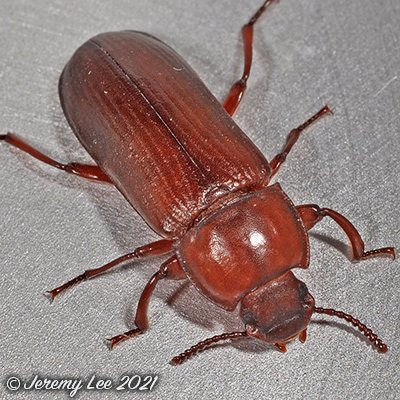
 |
|
Scientific Classifications explained » Amphibians » Ants » Aphids » Bees » Beetles » Birds » Bugs » Butterflies » Caterpillars » Damselflies » Dragonflies » Earwigs » Flies » Frog/Leafhoppers » Fungi » Galls » Grasshoppers » Harvestmen » Hoverflies » Lacewings » Ladybirds » Leaf Mines » Lichens » Mammals » Millipedes » Mosses » Moths » Sawflies » Slugs » Snails » Spiders » Trees & Shrubs » Wasps » Wild Flowers » Woodlice » Postboxes |
UK Nature > Beetles > Tenebrio molitor

Scientific Name: Tenebrio molitor Common Name: Yellow Mealworm Beetle Tenebrio molitor, more commonly known as the Yellow Mealworm Beetle, is considered a scavenger and is amongst the largest insects that infest stored products. Most prefer to feed on decaying grain or milled cereals in damp, poor conditions. These insects are usually found in places not frequently disturbed such as dark corners, under sacks, in bins and where feed is stored. Indoors, they are usually found in basements or at ground level, sometimes infesting cornmeal, flour, cake mixes, cereals, meat scraps, dead insects, bran and litter from chicken houses, they have even been found in sparrow's nests where they feed on the droppings. Mealworms have been found living under old carpeting and in straw-stuffed chairs in damp areas. Yellow mealworm larvae are sometimes known as "golden grubs" and make excellent fish bait and serve as food for animals in aquariums and zoological parks as well as wild bird food. |
|

https://www.uknature.co.uk is a website dedicated to showing the immense diversity of UK nature and wildlife. Our vast range of habitats, from lowland arable to snow covered mountains, from storm-ravaged coastlines to peaceful inland freshwater lakes and rivers, from dry, sandy heaths to deciduous and coniferous forests, all these habitats contribute to the abundance of UK nature. We have wild birds in huge numbers either residing or visiting our shores (597 recorded species as at July 2013) and we must also not forget the humble back garden with its grass lawns, flower beds filled with nectar rich flowers, shrubs and trees, all designed to attract huge numbers of insects such as bees, moths, butterflies and hoverflies; and finally the small ponds which provide safe havens for frogs, toads, newts and even slow worms and grass snakes. www.uknature.co.uk is the showcase for my personal passion, photographing uknature in all its glory. I sincerely hope you all enjoy the fruits of my labours. This site and all images contained therein is © Jeremy Lee 2004 - 2025. All Rights Reserved. Site design by Jeremy Lee. Site development & IT Support by Stuart Lee. |